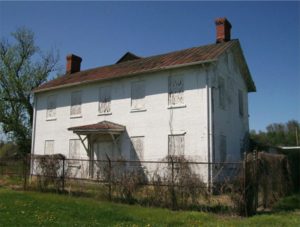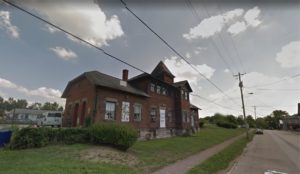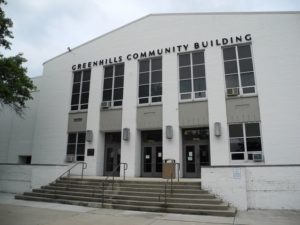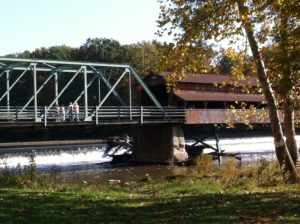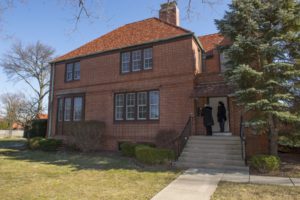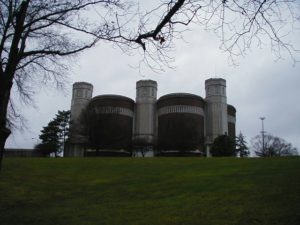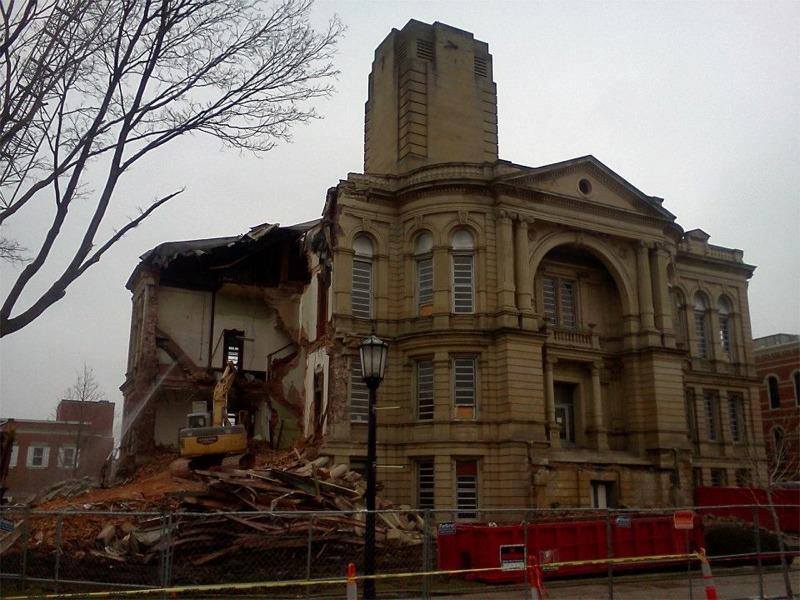The 2018 List of Ohio’s Most Endangered Historic Sites
Barker House, Newport (near Marietta), OH (Washington County)
The 1842 nationally, state, and locally significant Judge Joseph Barker Jr. House is of federal style architecture constructed by his father, Col. Joseph Barker, one of Ohio’s earliest and most skilled housewrights. The Barkers and the house have played an important role in shaping Ohio’s history. It is threatened with imminent demolition by its owner, the U. S. Army Corps of Engineers, to make room for material dredged from the Ohio River. Although land has been donated, fundraising efforts have thus far fallen short of the amount needed to move it.
Wikipedia article on the Barker House
“New hope for Barker house” – Marietta Times – September 12, 2018
Marble Cliff Gateway Mansion, Columbus, OH (Franklin County)
Renowned Columbus Architect Frank Packard designed this Tudor Revival style house which was built in 1907 for William Lanman of the Columbus Bolt Company and his family. In 1935, William “Billy” Ingram, founder of White Castle, bought the home when he moved the company from Wichita, Kansas to Columbus. The building has been deteriorating and is in danger of being lost due to apartment development plans.
“Marble Cliff to revisit apartment proposal that would raze historic mansion” – Columbus Dispatch – April 13, 2018
Marble Cliff Gateway Mansion 2018 Most Endangered Listing – Columbus Landmarks Foundation – Updated on July 16, 2018
CSX Railroad Station, Delaware, OH (Delaware County)
This architecturally interesting brick train station built during the early 1900s was the hub of many important political and cultural events during the heyday of the railroad transportation industry. It remains an endearing spot in the cultural landscape of Delaware. The building has been vacant and deteriorating for many years. Negotiations for sale of the property have thus far been unsuccessful.
Historic Integrity of the Village of Greenhills, Greenhills, OH (Hamilton County)
This 1938 planned village is one of only three remaining Greenbelt Communities in the Nation.The State of Ohio recognized the Historic District in 1989. The U. S. Department of the Interior awarded the National Historic Landmark status in December 2017. A total of 87 demolitions have already occurred, which have damaged the historic fiber of the community.
“The New Deal Landmark that’s Cannibalizing Itself” – City Lab – January 31, 2018
Historic Warren County Jail, Lebanon, OH (Warren County)
This 1889 – 1894 structure is a contributing part of Lebanon’s East End National Historic District and for more than 120 years has occupied a prominent place at the center of Lebanon’s civic life. The 1894 Sheriff’s Residence portion of the building, which forms the street façade, is the only surviving example of a Richardsonian Romanesque public building in Lebanon. The county has been unable to identify sufficient funding to renovate the building for reuse.
Salesian Boys and Girls Club, Columbus, OH (Franklin County)
This site was built in 1927 as an athletic club, auditorium and headquarters for the Knights of Columbus. Designed by the well-known local architecture firm, Richards, McCarty and Bulford, the building is five stories tall and ornamented and decorated in the Beaux Arts style which was popular in that period. The building was acquired by the Salesian Society in 1968 and used as a Boys and Girls Club. It is currently for sale. The status and future of the building remain uncertain, with rumored development plans that call for demolition.
Salesian Boys and Girls Club 2018 Most Endangered Listing – Columbus Landmarks Foundation – Updated on January 4, 2019
Harpersfield Covered Bridge & Steel Bridge, Harpersfield Twp. (Ashtabula County)
Constructed in 1868 and with a steel section added after the 1913 Flood, the Harpersfield Covered Bridge anchors Harpersfield Covered Bridge Metropark and provides a picturesque backdrop for the breathtaking Grand River, a National and State Scenic River. At 228 feet long, it remains Ohio’s third longest historic covered bridge and is listed on the National Register of Historic Places. Ashtabula County has plans to replace this structure with a new bridge in 2021.
Hartman Farm Schoolhouse, Hamilton Township (Franklin County)
This circa 1897 one-room schoolhouse in the Hamilton Township district served all grades. It later became a part of Dr. Samuel B. Hartman’s farm established in the early 1900s, where it was absorbed into what was known as the “largest functioning farm in the world.” The building has been standing vacant for years and continues to deteriorate. Interested parties have been unable to amass sufficient funds to move the school.
Brick Quarters Historic District at Wright-Patterson AFB Fairborn, OH (Greene County)
The National Register-eligible Brick Quarters Historic District (BQHD) at Wright-Patterson Air Force Base consists of a planned enclave of 89 brick homes built in the mid-1930s as a part of the Garden City movement and designed by noted architects. This Tudor-style site remains a significant example of early civilian planning principles in a military setting. Despite a two-year delay in any action, the brick quarters are still at potential risk of demolition.
Defiance Junior High School, Defiance, OH (Defiance County)
This 1918 Collegiate Gothic style architecture school building is situated at the end of the designated Main Street in Defiance, Ohio therefore making it the focal point at the end of the business district. The school district plans to demolish this building by November 2018 unless another option is agreed upon.
“Defiance Jr. High School makes list of Ohio’s most endangered historic sites” – 13abc.com – August 21, 2018
:”Defiance school board hears senior housing proposal for 1918 building” – Defiance Crescent-News – December 13, 2018
Mount Airy Water Towers, Cincinnati, OH (Hamilton County)
These iconic brick and cement water towers were built in 1926-27 and occupy the highest elevation in Cincinnati. They are a central point of the Mount Airy community and are adjacent to the 1500-acre Mount Airy Metropark. The towers, each holding 8.5 million gallons, have been left to deteriorate and the city is considering demolition of at least three of the seven towers in 2019.
Photos – click image for larger view:
